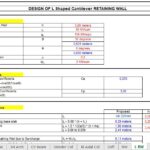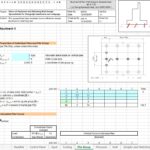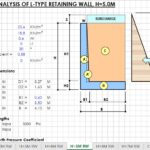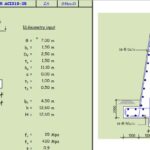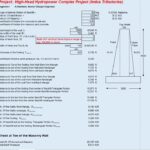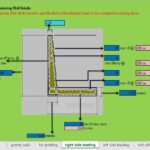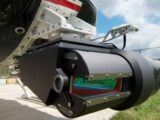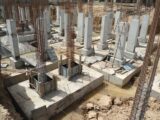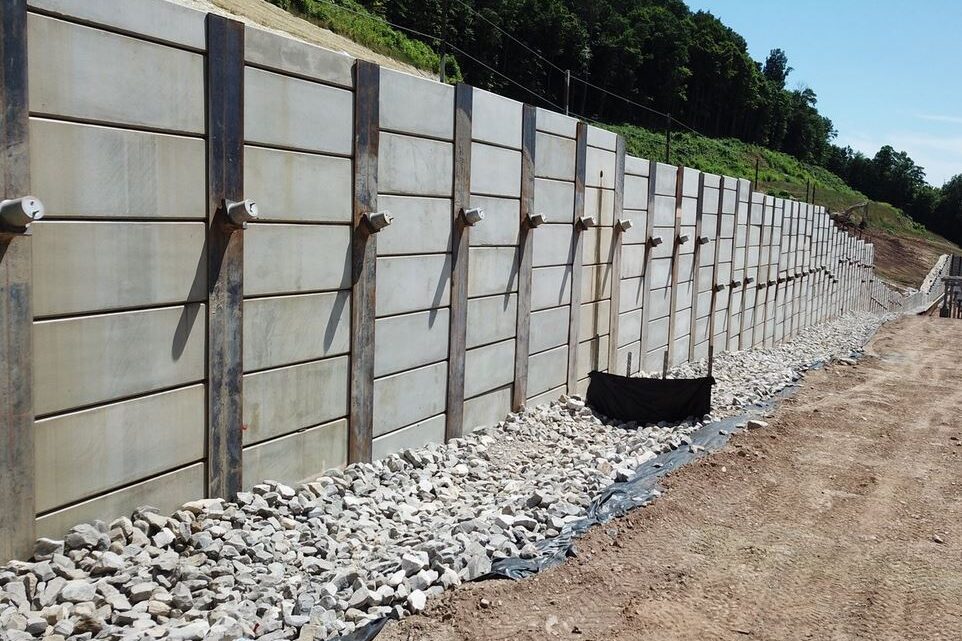
What is a Retaining Wall ? Types of Retaining Walls
16 July 2021Table of Contents
What is a Retaining Wall ? Types of Retaining Walls
Introduction:
A Retaining Wall is a structure that is designed and constructed to withstand lateral pressure of soil or hold back soil materials.
The lateral pressure could be also due to earth filling, liquid pressure, sand, and other granular materials behind the retaining wall structure.
Retaining walls are vertical or near-vertical structures designed to retain material on one side, preventing it from collapsing or slipping or preventing erosion. They provide support to terrain where the soil’s angle of repose is exceeded and it would otherwise collapse into a more natural form. The principal characteristic of a retaining wall is being able to withstand the pressure exerted by the retained material, which is usually soil.
The most important consideration in proper design and installation of retaining walls is to recognize and counteract the tendency of the retained material to move downslope due to gravity. This creates lateral earth pressure behind the wall which depends on the angle of internal friction (phi) and the cohesive strength (c) of the retained material, as well as the direction and magnitude of movement the retaining structure undergoes.
Lateral earth pressures are zero at the top of the wall and – in homogenous ground – increase proportionally to a maximum value at the lowest depth. Earth pressures will push the wall forward or overturn it if not properly addressed. Also, any groundwater behind the wall that is not dissipated by a drainage system causes hydrostatic pressure on the wall. The total pressure or thrust may be assumed to act at one-third from the lowest depth for lengthwise stretches of uniform height.
It is important to have proper drainage behind the wall in order to limit the pressure to the wall’s design value. Drainage materials will reduce or eliminate the hydrostatic pressure and improve the stability of the material behind the wall. Drystone retaining walls are normally self-draining. As an example, the International Building Code requires retaining walls to be designed to ensure stability against overturning, sliding, excessive foundation pressure and water uplift; and that they be designed for a safety factor of 1.5 against lateral sliding and overturning.
There ara various types of retaining wall structures which are used for numerous goals.
Gravity Retaining Wall :
Gravity retaining wall depends on its self weight only to resist earth pressure.
Commonly, gravity retaining wall is massive because it requires significant gravity load to counter act soil pressure.
Slidin, overturning and bearing forces shall be taken into consideration while this type of retaining wall structure is designed.
It can be constructed from different materials such as concrete, stone and masonry units.
Crib retaining wall, gabions and bin retaining wall are types of gravity retaining walls.
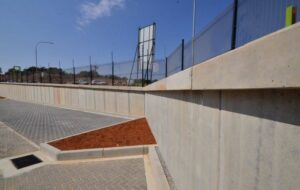
Gravity Retaining Wall
Crib Retaining Wall :
Crib Retaining Walls are low cost, of open web construction and can be quickly and inexpensively erected. They can be used almost anywhere a retaining wall is needed – driveways, building sites, garden areas, and when planted out will add beauty and value to your property.
Crib walls are gravity retaining walls constructed from interlocking precast concrete components, filled with free draining material and earth backfill, eliminating the hazards of hydrostatic pressure building up behind the wall.
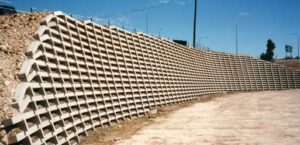
Crib Retaining Wall
Gabion Retaining Walls :
Gabion retaining walls are multi-celled, rectangular wire mesh boxes which are filled with rocks or other suitable materials.
It is employed for construction of erosion control structures and used to stabilize steep slopes.
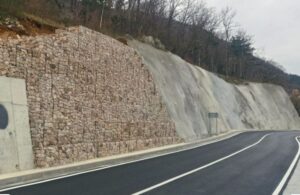
Gabion Retaining Walls
Cantiliver Retaining Wall :
Cantiliver retaining wall is composed of stem and base slab and is constructed from reinforced concrete, precast concrete or prestress concrete.
Cantiliver retaining wall is the most common type used as retaining walls.
Sometimes cantilevered walls are buttressed on the front, or include a counterfort on the back, to improve their strength resisting high loads. Buttresses are short wing walls at right angles to the main trend of the wall. These walls require rigid concrete footings below seasonal frost depth. This type of wall uses much less material than a traditional gravity wall.
The portion of the base slab beneath material is termed as heel, and the other part is called toe. It is economical up to height of 10m. Similar to gravity wall, sliding, overturning and bearing pressure shall be taken into consideration during its design.
There are 3 different types of cantiliver retaining walls :
- T – shaped cantiliver retaining wall
- L – shaped cantiliver retaining wall
- T – shaped cantiliver retaining wall with shear key
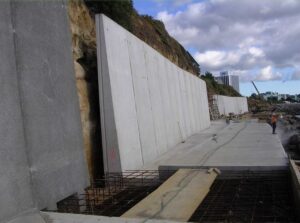
Cantiliver Retaining Wall
Counter-fort / Buttressed Retaining Wall :
It is a cantiliver retaining wall but strengthened with counter forts monolithic with the back of the wall slab and base slab.
Counter fort spacing is equal or slightly larger than half of the counter-fort height. It’s height ranges from 8 to 12m.
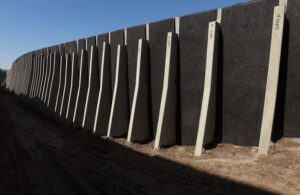
Counter-fort Retaining Wall
A buttress wall is the modified version of the counter-fort retaining wall in which the counter-forts, known as the buttresses, are provided at the other side of the backfill.
A buttress wall is more economical when compared to a counter-fort retaining wall. Buttress walls are not much preferred due to the provision of buttresses in the wall. These buttresses reduc the clearance on the front side of the wall.
Buttresses are short wing walls at right angles to the main trend of the wall. These walls require rigid concrete footings below seasonal frost depth. This type of wall uses much less material than a traditional gravity wall.
Anchored Retaining Wall :
This type of retaining wall is used when the space is limited or thin retaining wall is required.
Anchored retaining wall is suitable for loos soil over rocks. Considerably high retaining wall can be constructed using this type of retaining wall structure system.
Deep cable rods or wires are driven deep sideways into the earth, then the ends are filled with concrete to provide anchor.
Anchors (tiebacks) actes against overturning and sliding pressure.
Advantages of anchored retaining walls
- Mostly used for slope protection and earth retaining works of deep excavations.
- Thin walls or very light structures can be designed in combinations with anchored walls.
- Anchored walls are one of the most economical system of earth retention.
- Combination with sheet piles, cantilever retaining walls, piled retaining walls etc are very much useful for very deep excavations to provide a safe working area
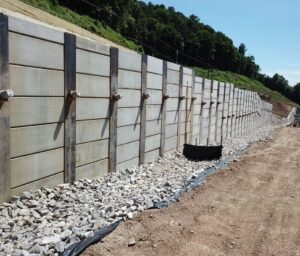
Anchored Retaining Wall
Piled Retaining Wall :
Pile retaining wall is constructed by driving reinforced concrete piles adjacent to each other. Piles are forced into a depth that is sufficient to counter the force which tries to push over the wall.
Sheet pile walls are built using steel sheets into a slope or excavations up to a required depth, but it cannot withstand very high pressure. They are economical till height of 6m.
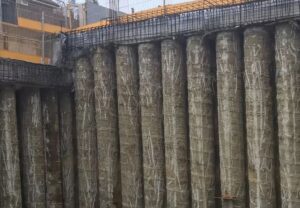
Piled Retainng wall
Mechanically Stabilized Earth (MSE) Retaining Wall :
It is among the most economical and most commonly constructed retaining walls. Mechanically stabilized earth retaing wall is supported by selected fills (granular) and held together by reinforcements, which can be either metallic strips or plastic meshes.
Types of MSE retaining wall include panel, concrete block and temporary earth retaining walls.
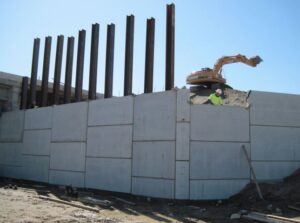
Mechanically Stabilized Earth (MSE) Walls
Hybrid Systems :
Retaining walls that use both mass and reinforcement for stability are termed as Hybrid or Composite retaining wall systems.

